Sixty years ago, the Beatles performed at Lewisham Odeon, one of their two performances there in 1963 as they rocketed to superstardom and Beatlemania gripped the country’s youth.

29 March – the Roe/Montez tour
The first Beatles show in Lewisham on 29 March was as part of a tour package headlined by American singers Tommy Roe, who had had a US Billboard Number 1 with the heavily Buddy-Holly-influenced Sheila (and later co-wrote the UK Number 1 hit Dizzy), and Chris Montez, most famous for Let’s Dance, which had reached number 2 in the UK charts. The Beatles were booked as one of the support acts. This was the first tour on which the Beatles played in London (with the tour’s opening night in East Ham their first show in the city), their manager Brian Epstein being keen that they had a hit single before playing in the capital.
By the time of the tour, they had already had that big hit single with ‘Please Please Me’ (reaching either Number 1 or 2 depending which chart you followed) and were increasingly becoming more popular than the headliners, so – much to their apparent embarrassment – they were moved up the bill. By the time they played at Lewisham Odeon they had also released the album Please Please Me, which was (soon afterwards) to reach number one.

The acts drove up to Lewisham on the morning of Friday 29 March fom Exeter where they had played the previous night. According to the book Beatlemania! by Michael Creasy, they arrived after this 206-mile journey at 4.30pm ahead of two shows at the Odeon, but still found time to talk to Lewisham Borough News journalist Paula Gracey, telling her about their love of classical music and jazz, as well as some contemporary acts, and about their recent tour with Helen Shapiro.
According to the Beatles Bible website, the setlist for this tour contained six songs: ‘Love Me Do’ (which had been their first single, reaching number 4 in 1962), ‘Misery’, ‘A Taste Of Honey’, ‘Do You Want To Know A Secret’, ‘Please Please Me’ and ‘I Saw Her Standing There’. All the songs were from their debut album, and all were written by John Lennon and Paul McCartney apart from ‘A Taste of Honey’, which was from the play of the same name.
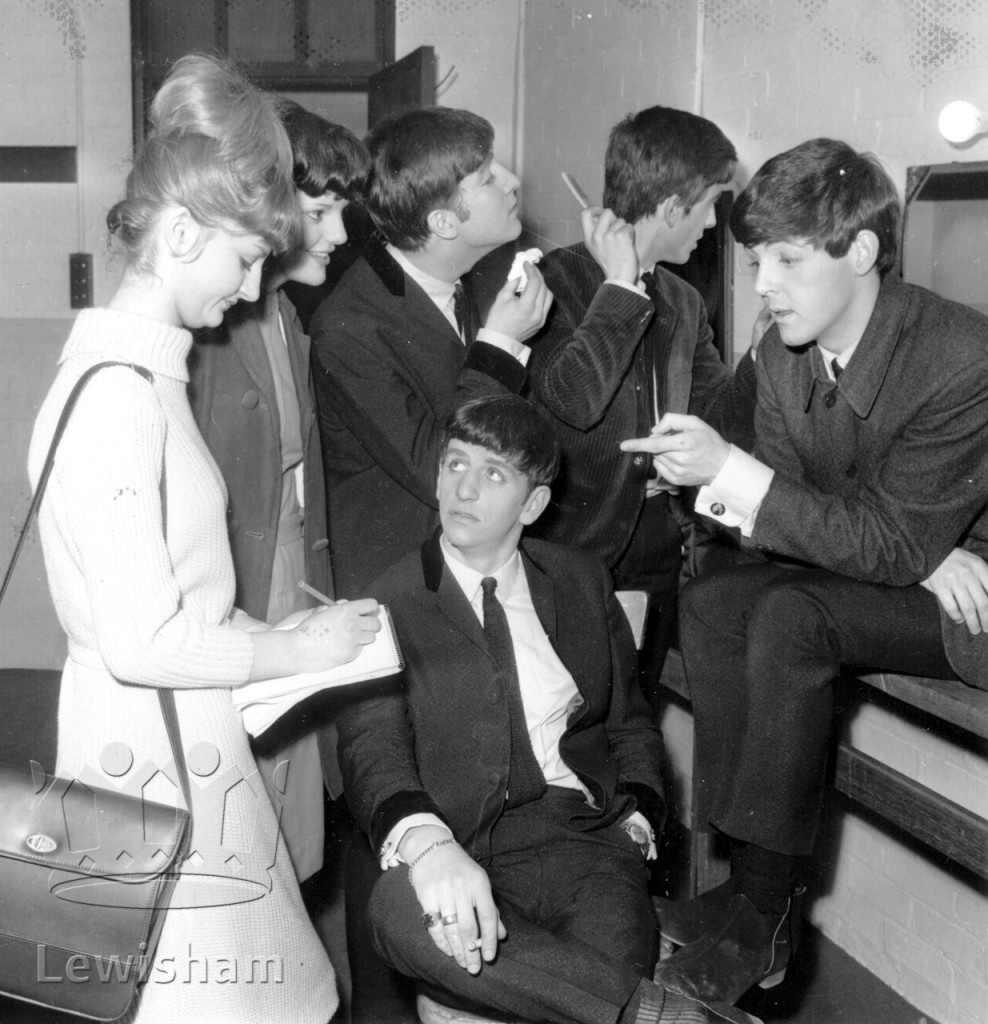
Lewisham Odeon as an early rock venue
The Odeon, which stood at the Lewisham High Street end of Loampit Vale, had opened at the Gaumont cinema in the 1930s – the largest cinema in the borough and one of the biggest in London.

In the late 1950s, its manager Keith Hann seems to have been keen to make it a venue for rock and roll music. The extent to which he had a choice is not clear, since a lot of Gaumont cinemas hosted rock and roll concerts by the early 1960s. Hann was, however, a defender of this new musical trend, speaking out on the topic after his cinema witnessed riotous behaviour at a showing of the film Rock Around the Clock in 1956.
In April 1959 the Gaumont hosted Cliff Richard and the crowds went wild. Under the headline “Rock ‘n’ Roll Fans Halt Traffic” the Lewisham Borough News reported that, after a show in which it looked like the fans would surge onto the stage, they instead surged into Loampit Vale to see their hero as he left the venue:
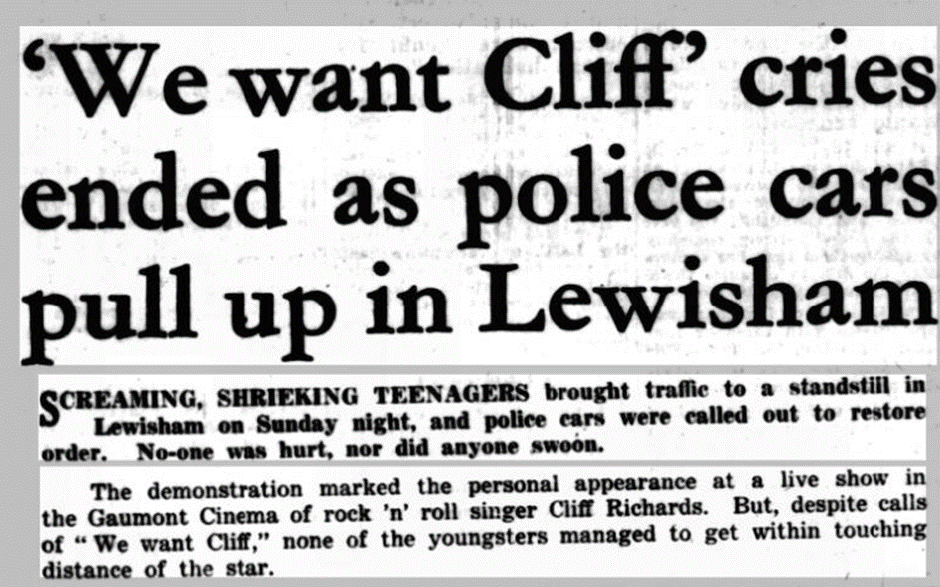
The venue also hosted Marty Wilde in 1959 and 1961, and Cliff Richard again in 1961 – where similar scenes occurred (Sydenham Gazette, 24/2/1961).
One might assume that Ella Fitzgerald’s shows were rather less affected by rowdiness, although an advert for her 1962 show apparently read “Set Yourself Alight and meet the great Ella”. This was was rather unfortunate as it appeared outside the venue as a major fire took hold just a few days before days the gig, which had to be rearranged elsewhere. The badly-damaged cinema was refurbished and reopened in July as the Odeon, Gaumont-British and Odeon both being owned by the Rank Corporation by the 1960s.
The Roe/Montez/Beatles show was not the only rock and roll package tour to play at the venue in 1963. On 31 October, a show by Little Richard, Bo Diddley and others included the Rolling Stones on their first ever tour. It was attended by Beatle George Harrison (whose bandmates had donated the Stones their second single, released the following day) and – as Transpontine has reported – by Beckenham teenager David Jones, who was inspired by the show and would return to the venue a decade later in some style as David Bowie on his Ziggy Stardust tour.
8 December – the Beatles Show
By the time they returned to Lewisham on 8 December, the Beatles had gone stratospheric. There was now no question over whether they should headline. Instead this was “The Beatles Show” with a range of support acts. A handbill for the show lists the Brook Brothers, Peter Jay and the Jaywalkers, Vernons Girls, the Kestrels and Frank Berry as the other acts on the bill.
Tickets for the shows were advertised to go on sale at 10.30 on Friday morning, 15 November 1963. The first fan arrived at 6am on the Thursday. By that evening the queue reached down the side of the cinema and round the other side (presumably the Rennell Street side of the cinema, towards the High Street). This huge crowd of people stayed there overnight, despite the icy winds and rain. The cinema staff served drinks and hot dogs, and people were able to leave the queue in turn to get food, while friends and family also brought supplies along to others in the queue.
The police had forty men and women on duty and in the morning asked the staff to open the box office 40 minutes early to ease the pressure. Three banks of police officers were needed at the box office to regulate the flow of people at the front to the queue.
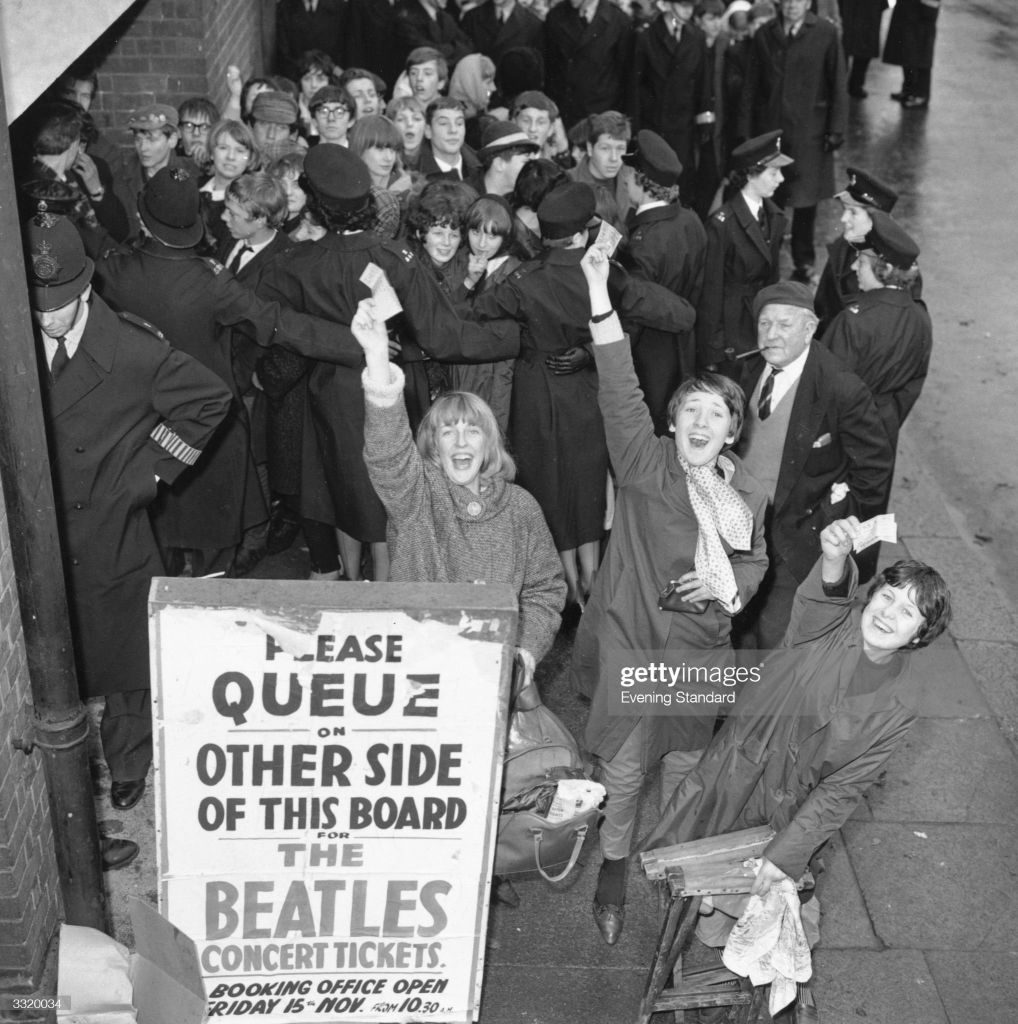
Reporting the queue and the upcoming concert under the headline, “Another problem: how will the Beatles get in? And police think that it will be tougher to find a way out again,” the Lewisham Borough News (19/11/63) reported that the police were pondering how the band were going to get in and away again. Due to regulations about flying over densely populated areas, “the Beatles—despite reports to the contrary—will not arrive by helicopter”.
By the time of the concert, the Beatles had released ‘I Want to Hold You Hand’, their third number one (or forth, if you count ‘Please Please Me’), and their second album, With the Beatles. The week before the concert they had five records in the top 20 of the Hit Parade.
Not everyone was enamoured with the band, of course. One critic was Conservative MP for Lewisham West Henry Price, former chairman of the Middle Class Alliance. He told a group of Conservative women in Sydenham that people aged 15 to 25 were hypotised by instruments that “look like guitars”: “Their eyes become glazed, their mouths gape, their hands wobble loosely and their legs wobble just as loosely at their knees.” He identified the Fab Four as the vanguard of this, and his rallying cry to those who were not caught up in the craze, “We’ve got the beat the beat of the Beatles”, was paraphrased in the Daily Mirror‘s headline (5/12/1963)
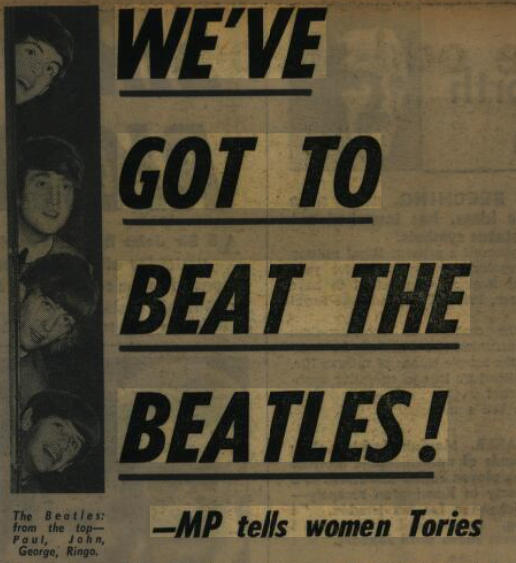
It’s fair to say that Price did not win over Lewisham’s youth ahead of the concert.
The weekend of 7 and 8 December was a busy one for the Beatles. On the Saturday, they recorded an appearance on Juke Box Jury (they were the entire jury), then a special fan club show at the Liverpool Empire that was broadcast on television. That evening they played two shows at the Liverpool Odeon.
On the morning of Sunday the 8th they flew down to London and made their way to Lewisham.
The local paper reported:
“Their Austin Princess, as scheduled, slipped into the yard of the Ladywell Police Station, unnoticed by passers-by, but soon members of the police canteen and officers who were off duty had gathered around the car collecting autographs for young members of their own families”
Lewisham Borough News, 10/12/1963
Paul McCartney got out and spoke with the LBN reporters and the police officers and canteen staff who were there, passing autograph books into the car for the other Beatles to sign. After a short time in the police yard, the Beatles’ car set out again with police cars ahead and behind, heading towards the venue.
Meanwhile the crowds were beginning to gather outside the Odeon. The police were out in force, with seven police horses in attendance. Two girls who were crushed in the crowd were treated by female officers before rejoining the queue. Even with this police support, “There was only sufficient space left at the stage door of the Odeon for the Beatles to dash through one by one.”
Once inside, they conducted a press conference with their manager Brian Epstein, who said that the Beatles were not (as rumoured) buying a row of houses to live and compose together (possibly the idea behind the adjoining terraced houses in the film Help?). The band talked about the film they were planning (1964’s A Hard Day’s Night) and their future recording plans.

Again, the Beatles Bible has the setlist. They performed a 10-song set (presumably the same at the each of the two shows): ‘I Saw Her Standing There’, ‘From Me To You’, ‘All My Loving’, ‘You Really Got A Hold On Me’, ‘Roll Over Beethoven’, ‘Boys’, ‘Till There Was You’, ‘She Loves You’, ‘Money (That’s What I Want)’ and ‘Twist And Shout’. It was a longer set than in March, but with more cover versions of other artists’ songs, only the first three songs and ‘She Loves You’ being Lennon and McCartney songs (at this stage, the other Beatles hadn’t started contributing songs to the band’s records).
Summing up the experience of the concert, the LBN’s reporter concluded:
They impressed me as a fine bunch of youths, boys with an eye on the future who know where they are going: a quartet who are splendid performers, and firm favourites with everyone—but why can we not hear their singing and reserve the shrieks and screams until later? …
Call it Beatlemania or what you like; to the teenage fans it was an evening to be always remembered. Maybe one day, I’ll understand!
Lewisham Borough News, 10/12/1963
The screaming and shrieking
The Beatles live shows were famous by then for the screaming of the audience, particularly the young girls. So what was it like in the Lewisham gig?
The LBN’s correspondent gives us an account of the experience:
All the other acts came over well, but when those Beatles appeared faces and ears were covered as girls rocked and bounced in their seats and shrieks ascended to the ceiling and re-echoed through the auditorium, which held almost 3,000 during each performance.
Lewisham Borough News, 10/12/1963
Strangely, there was also an account of the concert in the national press. Mr H.L. Walter, general manager of the Performing Rights Society, attended the show where, he said, he stuck out like a sore thumb sixth or seventh row “because all around me were children. They must have wondered what I was doing there.” Although the crowd was noisy, as 3,000 children were likely to be, he said:
My recollection is that there was very little screaming during the performance. I had no difficulty in listening to the music.
About this extraordinary phenomenon of screaming, let us remember that 3,000 girls are not screaming all the time. In my immediate vicinity there were probably two who had screamed all the time.
They bounce about and wave their hands but there were only these two girls who were really screaming, mouths open and never stopping.
Liverpool Echo, 13/12/63
He went on:
The whole hall is full of sound. It is a most extraordinary experience. You can say music is all around you. You have the impression that the whole hall is throbbing with sound—the sound of music. The screaming sets up a tremendous background. But you cannot overcome that sound, not while you are in the hall.
Hull Daily Mail, 14/12/63
Mr Walter was not, however, a neutral observer. He was giving evidence in a tribunal where his organisation was calling for an increase in the royalties paid to artists and composers for the performance of their works. The PRS, representing music composers and publishers, wanted the fee increased to 4% of box office takings, rather than the existing rate of 0.75% of the venue’s monetary capacity. Promoters, including the Cinematograph Exhibitors Association, opposed the claim and – slightly oddly – one of their arguments appears to have been that, because you couldn’t hear the music anyway at their concerts, they shouldn’t have to pay more for the rights.
So, while Mr Walter gave evidence that you could hear the music clearly, the other side stressed how loud the screaming was. Although one might think the Beatles were something of an outlier in the volume of their fans, they seem to have been the focus of the debate (although Cliff Richard and Adam Faith were also mentioned). The venue owners played recordings of a Beatles show to the tribunal, to demonstrate that the music was ‘drowned’ by the screams. (Newcastle Evening Chronicle, 10/12/63) They also offered the judge chairing the tribunal tickets to a Beatles show, which he turned down repeatedly. The tribunal concluded in February 1964, with an increase to 2% of box office takings or 1.75% of the monetary capacity of the venue (Daily Mirror, 7/2/64).
Those of us who weren’t there will never know quite what it was like, or how dominant the sound of screaming was. When you see the videos of the shows, you see something of what Walter and the LBN report described, with fans passionately engaged in the music and intermittently screaming. With 3,000 in the Odeon they must have made quite a noise!
A 1964 show?
When the tour dates for the Beatles’ autumn 1964 tour were announced, they included a night at Lewisham Odeon on 24 October:
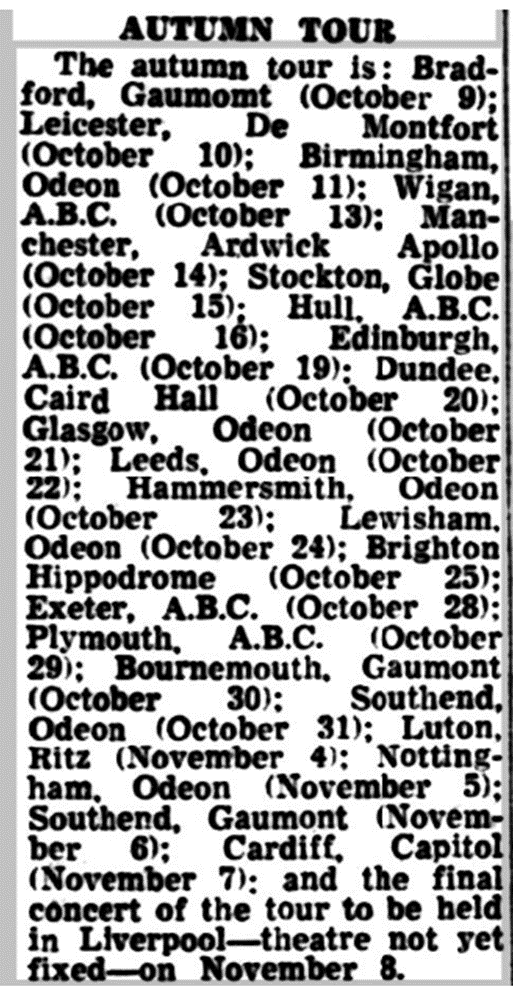
The show was never to be, however. The 23/24 October dates at Hammersmith and Lewisham were replaced by shows in Kilburn and Walthamstow. I haven’t been able to find a reason, but the initial dates appear to have been provisional so perhaps the alternative venues were simply preferred.
Perhaps the people of Lewisham could have put up a fight to save their date, though. When the young folk of Bristol found their city missing from the autumn tour they mounted a protest outside the venue the band had played there before, the Colston Hall (now Bristol Beacon). This appears to have been effective, as a date there was added to the end of the tour. Hopefully the Beatles fans of Lewisham were able to get to one of the other shows in Greater London, or one of the 20 Christmas Shows the band played at the Hammersmith Odeon.
The band played at Hammersmith Odeon again in December 1965 but quit touring in 1966 and never returned to Lewisham. Paul McCartney did perform on stage at the Odeon with Rod Stewart in 1974 and returned with Wings in 1979, not long before the venue closed down. It seems unlikely that the elaborate police precautions were needed by that time.